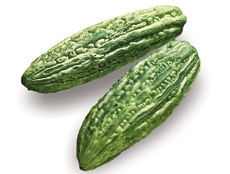
Bitter melons
Name Variations[]
- Goya
- balsam pear
- bitter cucumber
- bitter gourd
- ampalaya
- Chinese bitter melon
- foo gwa
- karela
- cerasse
About bitter melon[]
The bitter melon (Chinese: 苦瓜; Hanyu Pinyin: kǔguā), also called bitter gourd, karela (from Hindi), hAgala kAyi (from Kannada), pavakka (from Tamil), pare or parai (from Malay and Indonesian), ampalaya (from Filipino), balsampear, or balsamapple, is the edible fruit of the tropical and subtropical plant Momordica charantia, named for its bitter taste. Bitter melon is actually a member of the squash family and resembles a cucumber with bumpy skin. When first picked, a bitter melon is yellow-green, but as it ripens, it turns to a yellow-orange color. It is considered one of the most bitter among all edible vegetables. The young shoots and leaves of the plant may be eaten as greens, and are not particularly bitter.
The bitter melon has a distinct warty texture and an oblong shape, about 10 to 20 cm long with bluntly tapering ends. It is most often eaten green, but can also be eaten when it has ripened and turned yellowish or reddish orange. The seeds are white in raw fruits and become red when they are ripe. There are two varieties of this vegetable. The large kind is long, oblong and pale green in color. The other kind is small, litte oval and dark green. Both turn orange when ripe.
The original home of bitter gourd is not known except that it is a native of the tropics. It is widely grown in South Asia and Southeast Asia, as well as in China and the Caribbean. It is often used in Chinese cooking for its bitter flavour. It is also cultivated extensively all over India and a type of chips called karela chips are quite relished. It is however seldom mixed with other vegetables due to its extreme bitterness.
Bitter melons also have various uses as traditional medicine around the world, and has potential use for treating HIV infections. Bitter melon is also used often in Okinawan cuisine; it is called gōyā in Okinawa. In Indian ayurvedic medicine, it is popularly seen as a "plant-insulin" and is thus highly recommended for diabetics. It is called ampalaya and prepared into a dish in the Philippines. Even in western medicine due to its high nutrition content it is advised that patients take this vegetable regularly. The inside of the melon is filled with fibrous seeds. Bitter melon is used mostly in Asian and Indian cooking.
Selection[]
Select firm, unblemished melons that are from 5 to 12 inches in length. Choose melons that are still green for a more bitter flavor and a yellow-orange melon for a milder taste. Bitter melons are available fresh from April to September in most Asian markets and can occasionally be found in larger supermarkets. Some markets are beginning to carry bitter melons year round. They may also be purchased canned or dried.
Storage[]
Store melon loose in a paper or plastic bag in the refrigerator for 3 to 5 days. Slice the melon immediately before use.
Preparation[]
Cut in half and discard the seeds and fibrous core. To reduce the bitterness, blanch in boiling water for 2 to 3 minutes. The skin is edible and the melon is not typically peeled. The seeds are also edible, unless very hard, and are included in some recipes. Bitter melon is commonly stuffed, curried or pickled. It can also be used in stir-fry’s and soups and may be steamed. Garlic or chili peppers are often added to recipes with bitter melon to offset the bitter taste.
Bitter melon Recipes[]
Source[]
- Exotic Vegetables from Fruits and Veggies Matter's Vegetable of the Month by the US Center for Disease Control and Prevention, public domain government resource—original source of article
